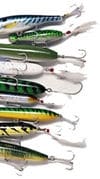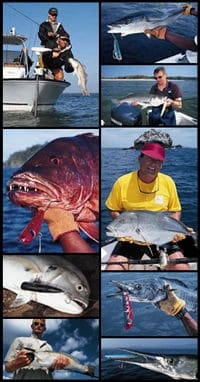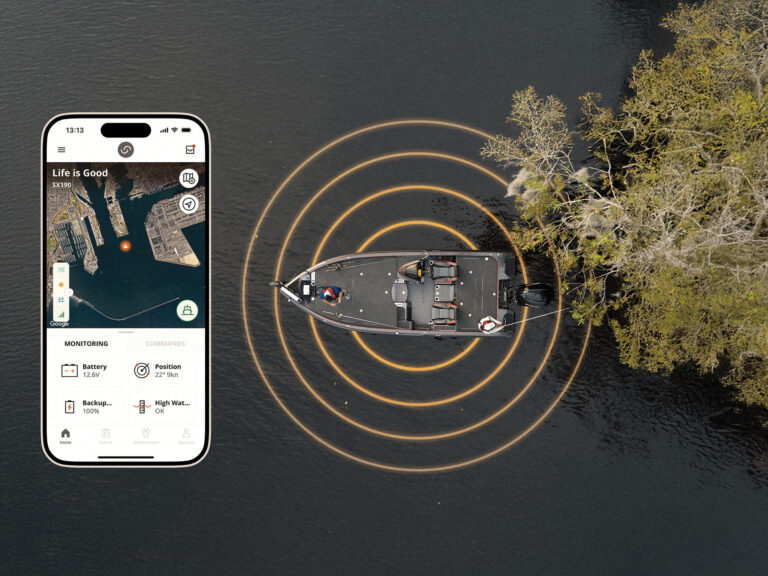
For most anglers, it’s the memories of fish caught that most endure. However, those of us who find fishing’s ultimate thrills in surface action are often just as happy with the spectacular misses. Think topwater explosions produced by crazed game fish intent on devouring your lure and you’ll know what I mean.
Not every game fish can be raised with a popping plug, of course, but most can’t resist the temptation to blast what appears to be a helpless meal – even if they have no idea just what it is. That even applies to fish that aren’t hungry. Several decades ago, scientists at the Sandy Hook Marine Lab in New Jersey found that bluefish kept in captivity would feed on baitfish until sated, then resume a normal swimming pattern along with the remaining prey. However, the introduction of another type of forage, such as an eel, would immediately trigger a feeding response. I’ve witnessed the same reaction many times on the water, as blues with bulging stomachs would blast a popper they couldn’t possibly swallow.
Striped bass can be very fussy when feeding on small bait, but more often than not they can be induced to hit something that is much larger than the prevailing forage. During the fall migration along the northern New Jersey coast, I’ve taken up to 150 bass a day on poppers. This type of scenario is the perfect way to introduce beginners to the sport, since they can enjoy lots of action while getting the hang of casting and retrieving a lure.
Amberjack are another fish that just can’t seem to resist a popper. Decades ago, while fishing with SWS Carolinas Editor Joel Arrington off North Carolina, we located a mass of 25- to 40-pound amberjack that were holding over a shallow wreck. After we had caught a few, the AJs developed a case of lockjaw, and even refused to hit live baits. However, they would follow and attack a popper on every cast. After a while, we removed the hooks and took to swishing the popper back and forth next to the boat, watching as the charged-up amberjacks blasted the plug time after time!

Bluefish often fall over themselves to eat a popper – small wonder they’re a favorite topwater target from Maine to Florida.|
Cubera Explosions
Poppers will also bring unexpected creatures to the surface. Pacific cubera snapper not only respond to poppers, they sometimes make spectacular strikes that often carry them completely out of the water. Believe me, it’s an amazing sight when a hefty cubera launches itself into the air and falls back on the popper with a crash that sounds as if a garage door had fallen into the ocean. More often than not they miss the plug, but the explosiveness of the strike is not easily forgotten.
When game fish are really turned on to poppers, it’s sometimes hard not to hook them. This is especially true with jacks and bluefish. It’s common to have one fish shake the plug loose underwater, only to have another grab it before the lure can float back to the surface. Some game fish get so worked up over a popper that more than one can be taken on the same lure! I’ve had this happen many times with small bluefish, and at least a couple of times with larger choppers.
When the action is that hot, it makes sense to crimp the barbs on your hooks for the sake of safety and ease of release. Indeed, if it’s the strike you value more than the fight, try removing the hooks altogether and simply watch the fireworks!
Try ‘Em on Tuna
While virtually every game fish finds poppers attractive, some species are less willing than others to commit to a strike. Tuna fall into that category at times, because they require such a fast retrieve, although that doesn’t apply when they’re feeding.

Poppers on parade: (top to bottom) Gibbs Polaris, Rapala Skitter Pop, Creek Chub Striper Strike, Yo-Zuri Surface Cruiser, Gibbs Polaris, Atom Atomizer, Yo-Zuri Hydro Tiger,Storm Chug Bug, Cordell Pencil Popper.|
Captain Peace Marvel discovered the excitement of casting poppers to yellowfin tuna off Venice, Louisiana, a few years ago. Faced with tuna that were feeding on scad, but wouldn’t touch his baits, he dug a Yo-Zuri Hydro Tiger out of his tackle box and was surprised when it was immediately attacked. Since then he keeps dozens of poppers on board in case he runs into the same situation.
Marvel fishes his poppers on heavy spinning tackle and 400 yards of 90-pound braided line, which is still pretty light for 100- to 200-pound yellowfins. His charter parties have boated tuna up to 132 pounds on this gear, though much larger fish have been lost after long fights.
Roosterfish are one of the most exciting inshore fish to take on poppers. They love to follow a topwater, but the great majority never strike. When that tall, comb-like dorsal fin rises behind the plug, a strike always seems imminent. However, the norm is for the fish to follow the lure all the way to the boat before turning away at the last second. Your chances are a lot better if more than one fish is following, although even that’s not a sure thing by any means.
Jacks are among the most aggressive fish in the ocean, partly because they travel in schools of like-minded kin. They are certainly among the strongest of all fish, and also have a unique ability to bend hooks and open split rings. Just as with tunas, it’s important to use every possible bit of drag when fighting these fish unless you want to be tied up for a long time.
Chuggers & Dancers
Poppers fall into two basic categories: cupped-face plugs and pencil poppers. Most anglers are familiar the first type, which are relatively easy to work with an intermittent jerking action that creates a “pop-pause-pop” action. Speed of retrieve is adjusted according to species: relatively slow for striped bass, a bit faster for bluefish, and much faster for tunas and most tropical species. Though poppers were once crafted from wood, Bob Pond popularized them with his Atom Striper Swiper, which was, and still is, made of synthetic material. That led to the development of many other salt water poppers, including the Yo-Zuri Hydro Tiger, Gag’s Grabber, Creek Chub Striper Strike and Cordell Near Nuthin.
A variation of the traditional popper is the “bottleneck” popper, such as the Gibbs Polaris. These poppers feature a heavy, teardrop-shaped bottom and a cupped head, and can be cast long distances, even into a stiff wind. Atom has recently unveiled a new synthetic version of the bottleneck popper called the Atomizer.

. . .and more poppers: Rapala Skitter Pop, Gibbs Polaris, Gibbs Pencil Popper, Atom Striper Swiper, Atom Swingin’ Swiper, Gags Grabbers Popper, Yo-Zuri Hydro Tiger, Creek Chub Striper Strike, Yo-Zuri Hydro Tiger.|
Stan Gibbs was the creator of the now-famous pencil popper, which I learned how to use while fishing with the master himself on Cape Cod during the mid-1960s. Rather than having a concave face and being designed to float horizontally, the pencil popper has a rounded, bulbous stern and tapers to a narrow head with little or no cupping. It presents a vertical appearance at rest and creates more splash than pop. Gibbs laboriously crafted his pencil poppers from wood, and his successors to the business continue to produce it this way. However, he never bothered to file a patent on the pencil popper design or name, and several competing manufacturers soon introduced their own versions of the plug.
Cotton Cordell was fishing with me in the Bahamas over 30 years ago when I demonstrated for him the effectiveness of the Gibbs pencil popper. Cordell went back to Arkansas and turned out a very good imitation in plastic, which may be the least expensive pencil popper on the market. Some anglers also swear by the lure’s rattle chamber, which was added later.
Yo-Zuri is a recent player in the pencil-popper game. Its offering is the Surface Cruiser, which is expensive, but practically indestructible. The same applies to the Mega Bait, another Asian import. Both lures are highly effective on a variety of fish.
Proper Popping Gear
Popper size should be balanced to the tackle being used, as well as to the fish you expect to encounter. Standard poppers of around two ounces are best fished on heavy spinning gear, while models half that weight are better suited to lighter tackle. Among pencil poppers, I find the 2 1/8-ounce, 6 3/4-inch Yo-Zuri Surface Cruiser to be ideal for casting with heavy spinning gear. The six-inch, 1 3/8-ounce model is a better size for lighter tackle; I often use it for casting to mixed-bag stripers and blues. The largest model – a 3 1/2-ounce, eight-inch version – is much more tiring to work and provides little extra distance. It’s more suitable for use with heavy conventional casting tackle, as is the Reverse Atom plug.
Bob Pond, inventor of the Reverse Atom, discovered that by reversing his big Atom Swimmer, removing the metal lip and drilling holes in the fat end, he had a lure that created a huge surface commotion and spurted water like a squid. The result was a type of pencil popper that was deadly on big stripers whenever squid entered shallow Cape Cod areas, and surfcasters could throw it a mile after loading the 3 1/4-ounce plug with water. Though not available for many years, the Reverse has recently returned to the Atom line.
Fast-taper rods with long butts are advisable for working pencil poppers. Most anglers think it’s harder to fish pencil poppers, but that’s simply because they’re trying to do so with their arms rather than their wrist. The trick to working pencil poppers is to brace the rod butt against your thigh and apply motion with a slight wrist action. I can literally cast pencil poppers all day with this technique, even in Panama, where I use a 10 1/2-foot, two-piece surf rod. The wrist action creates a side-to-side splashing motion in the popper that doesn’t require as fast a retrieve and can be slowed even further as the plug nears the boat.

Few game fish are immune to the seductive splashes of a well-worked popper, including (clockwise from top) redfish, rainbow runner, striped bass, bluefin trevally, wahoo, houndfish, speckled trout, jack crevalle and cubera snapper.|
One of the biggest mistakes anglers make when fishing a popper is taking the plug away from a following fish. I’ve seen roosterfish practically ram the boat while charging a popper that the fisherman continued to retrieve at a frantic pace. Stopping the retrieve almost never works, but slowing it down a bit will often inspire a strike. That’s much easier to do with a pencil popper, which can be made to bobble on the surface using lots of tip action and very little forward motion. With species such as cubera snapper, which immediately dive for cover after nailing the plug, I have learned that the best technique is to reel even faster when the fish first appears in order to draw it away from the rocks, then slow the retrieve just a bit to encourage a strike.
The Swish-and-Strike
It’s often possible to turn on schooling fish by using the same technique described earlier for amberjack. Simply swish the popper back and forth next to the boat until the fish get charged up enough to blast it. This sometimes works with Pacific barracuda, rainbow runners and dolphin. By the way, any time you’re working with a short length of line, be prepared for the plug to shoot back at you should it pull free of the fish’s mouth. That’s why it’s wise to always wear sunglasses and a hat.
As a vocal proponent of the pencil popper, I’m often asked what color is best. My reply is: “If the fish can see what color the lure is, you’re not working it right!” The pencil popper should hardly touch the water during the retrieve, and all the fish should see is a lot of splashing. Those beautiful color schemes are designed to catch fishermen, not fish. As a matter of fact, I’ve found that a Surface Cruiser stripped of paint will continue to produce every bit as well as one fresh out of the package.
Popping plugs work under a variety of conditions, from casting into a mass of breaking fish to blind-casting to reefs and rocks. Whether the strike is expected or a surprise, it’s always a thrill, one that’s guaranteed to hook the angler – if not always the fish.
¿
| # Rigging TipsWith the high cost of popping plugs these days, it’s logical to use a leader to reduce break-offs. I start with a short Bimini twist in the end of my main line, then use an Albright knot to tie on a leader ranging from 50-pound mono for stripers and blues to 80-pound for cubera snapper. No snap is used when large fish are a possibility, and I tie directly to the popper with an improved clinch knot, since I think the plugs work better that way than with a loop knot. Fluorcarbon leader is never a bad idea, but not essential, as the leader remains mostly above the surface during the retrieve. Swivels aren’t necessary with poppers, but can help avoid line twist caused by fish that tend to spin when hooked. Substituting a swivel for the Albright knot when connecting the leader shouldn’t hurt with standard poppers, but if one is used with a pencil popper it must be very light. ¿-Al Ristori |









